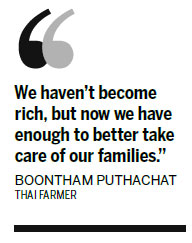Edible insects a boon to Thailand's farmers
Depending solely on the rains to either yield a good rice crop or leave their fields dry and barren, farmers in this village in northeastern Thailand, the country's poorest region, led a precarious and backbreaking existence. Then they discovered bugs.
At Boontham Puthachat's home, six concrete pens seethe with crickets munching on chicken feed, pumpkins and other vegetables - treats to fatten them up before they are harvested and sold to hungry humans increasingly eager for a different type of dining experience.
"We haven't become rich, but now we have enough to better take care of our families," Boontham said proudly. "We are self-sufficient."
Boontham's family is one of 30 in this village raising mounds of the profitable crisp and crunchy critters in their backyards, satisfying a big domestic appetite for edible insects, and a slowly emerging international one in countries where most diners would rather starve than sample fried grasshoppers or omelets studded with red-ant eggs.

Replicated across the country, these enterprises have spawned a multimillion-dollar industry with more than 20,000 registered farms, most of them small-scale household operations, according to the UN Food and Agriculture Organization. Averaging an annual output of 7,500 metric tons in recent years, Thailand leads the world in producing insects for the dining table.
While it may still seem exotic, if not outright repulsive, to many in the Western world, the FAO points out that insects have long been an integral part of human diets in nearly 100 countries, particularly in Asia, Africa and Latin America, with more than 1,600 species consumed.
In China, the use of insects for food and medicine goes back more than 5,000 years. In recent times, cockroach farming has flourished, with some entrepreneurs getting rich by selling dried cockroaches to companies producing cosmetics and traditional medicines.
Besides generating extra income, insects have proved nutritious, and farming them is easy on the environment, according to a 2013 FAO report.
"Eating a few insects is like taking a multivitamin," said Patrick B. Durst, a senior FAO official who co-authored a study on Thailand's edible insect industry. A 170-gram serving of crickets, for example, has 60 percent less saturated fat and twice as much vitamin B-12 as the same amount of ground beef. Farmers don't use antibiotics or growth hormones and - unlike crabs and lobsters - edible insects don't feed on dead animals.
"Six-legged livestock", as the agency calls them, are also kinder to the environment than their lesser-legged counterparts. It takes 11,000 liters of water, 11.3 kg of feed and extensive land to produce half a kilogram of beef, but just 4 liters of water, 1 kg of feed and a small cubicle to produce half a kilogram of crickets.
(China Daily 08/26/2014 page11)








